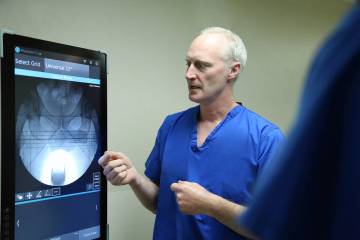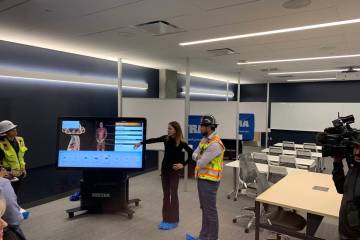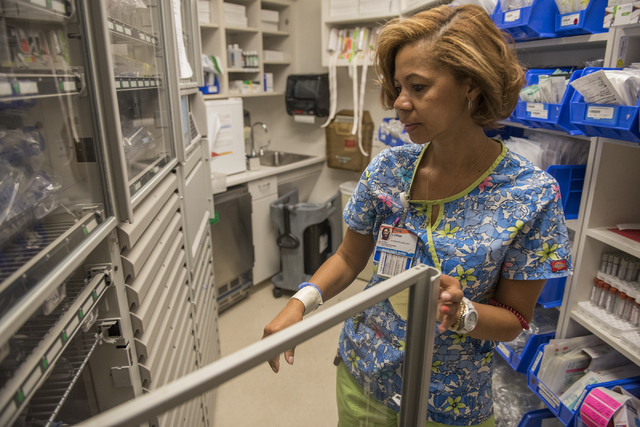
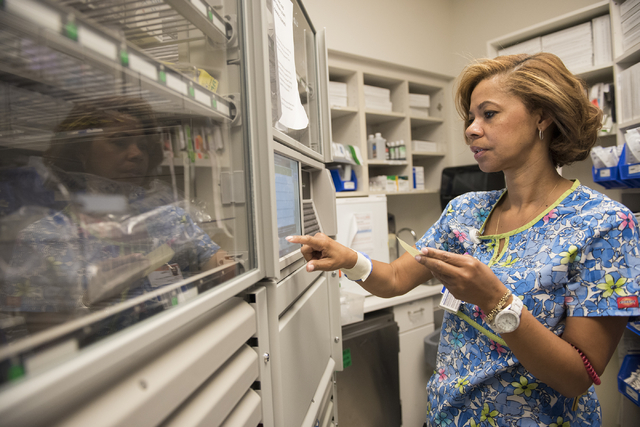
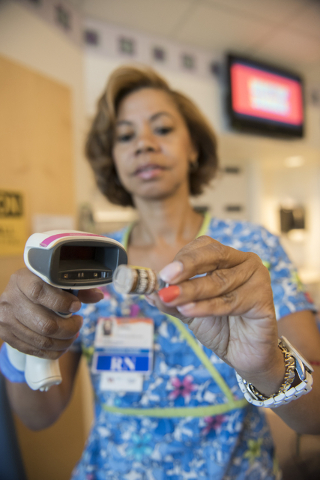
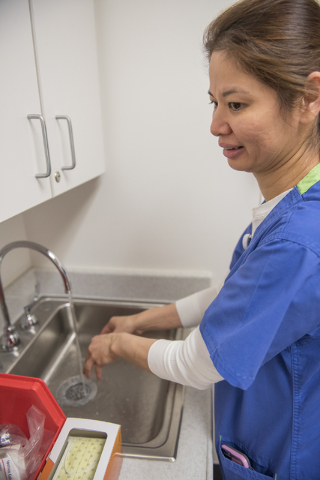
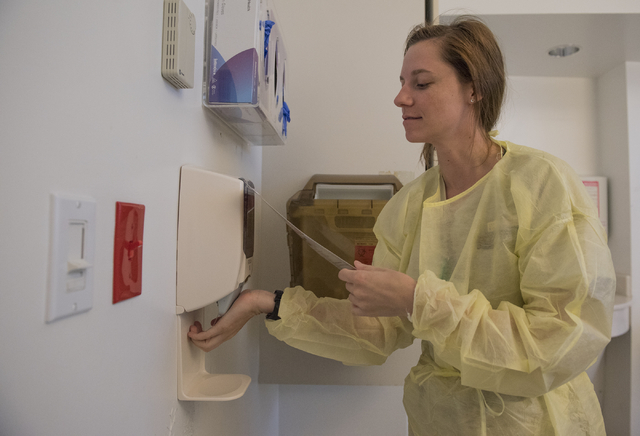
The Las Vegas medical community is focused on quality control and improving the level of care throughout the valley.
Nevada ranked seventh in the nation for overall improvements in cutting back on infections, falls and other complications and conditions that might occur in hospitals, said Jerry Reeves, vice president of medical affairs for HealthInsight Nevada, a nonprofit community-based organization that contracts with the federal government and hospitals to improve health care. Hospital readmissions are being avoided in greater numbers, improving the health of patients and saving money in the health care system.
“Patients come to us at their weakest moments, and we want to make sure our quality is second to none and that we are focusing on the best practices that improve outcomes and reduce those readmissions,” said Mason VanHouweling, University Medical Center CEO. “We have a lot of efforts and initiatives around our quality departments and down to the front-line staff that we do no harm to patients and that they have positive outcomes and all those metrics that are tracked and measured are going in the right direction.”
Robert Pretzlaff, chief medical officer for Dignity Health-St. Rose Dominican, said there has been a national spotlight on quality in health care.
It’s a focus that began in 2000, and Pretzlaff said it’s been like “a train that’s building up steam.” Every year, there are greater requirements from the federal government and more items to report on and issues to address.
“With the federal government, the state government, insurers and the insured looking over our shoulders in terms of quality, it keeps it a constant focus for us,” Pretzlaff said. “I think quality is improving every year.”
UMC, for example, has committees that involve staff members across the organization, and it invites patients to talk about their experiences so the feedback can be used to improve the processes, VanHouweling said.
“We are a teaching facility, so we are very focused on teaching the next generation of physicians and medical students about how important quality is and providing all of the evidence-based medicine to them so they can continue that forward.”
One focus is expanding the use of checklists. Starting a checklist within the medical community isn’t as easy as it seems, Reeves said. There has been considerable controversy about them throughout the country because doctors consider them “cookbook medicine.” Checklists and reviews make a difference, he said.
“When you actually look at videos of people who go in and out of the room and whether they wash their hands as they enter or exit the room, you find it doesn’t happen but 40 percent of the time, even in hospitals that are proud of what levels of health care-acquired infections they have,” Reeves said.
“People blow it. Humans make mistakes. Without systems to catch them and address them early, those mistakes keep piling on.
“It doesn’t matter how many years of training and medical school experience you have, you are still humans and humans make mistakes. Systems help prevent human-factor kinds of errors. You get distracted. You get a phone call or something else happens and you lose track of exactly where you were.”
Checklists are important in many areas to make sure UMC is standardizing the processes to produce positive outcomes, VanHouweling said. That’s something the health care industry has mirrored after the aviation industry, which always has had a safe record, he said.
“What you have seen over the past few years is the health care industry learning what they’re doing well and going through a particular checklist to make sure before we do any procedure that everybody is on the same page and everybody agrees that we’re ready to go,” he said.
VanHouweling said UMC also does a root cause analysis when something doesn’t go well. It brings the team together and discusses how things could be different the next time.
“We have a culture of less punitive versus ‘let’s learn from our experience,’ and it’s called a just culture,” VanHouweling said. “We want to make sure staff doesn’t feel intimidated and speaks up if they see something that’s not appropriate and or can potentially cause a patient harm.”
UMC uses a procedure called a timeout that’s part of the checklist procedure. It performs tasks such as checking to make sure it has the right patient and is doing the right procedure. Everyone stops what they’re doing and everything must be checked off before any incision is made and procedure started, he said. There’s even double counting of instruments and sponges.
“It has been helpful in the industry so we don’t have some of the things that you have heard about … in the past (such as the) wrong patient or wrong side,” VanHouweling said. “These things have really brought down those occurrences dramatically. That has been adopted by all of the hospitals in the valley, and it’s been very successful.”
The key for hospitals to reduce readmission rates is to make sure there’s a good transition care plan for the patient and make sure they are coordinating care once when they leave, hospital officials said. It’s about making sure patients have their medications, that the next appointment is scheduled with their primary care doctor and ensuring that home health care is lined up.
“We make sure they have their medications to get them through to their next visit, and we also make sure they have the equipment at home if they need oxygen or a nurse to come and visit them at home,” VanHouweling said. “We make sure our social services department and our nursing departments really do a great job of making sure that when a patient leaves this hospital that chance of readmission is minimal.”
When it comes to reducing infections, procedure centers around education of not only the staff and physicians but also patients and families officials said. Hospitals even look at supply products regularly to help reduce infections. Hospitals have infection departments that make rounds and work with nurses.
“I think there’s more discussion about quality than ever, and we put more hospital resources to it,” VanHouweling said. “We have created entire departments related to quality, and we brought in experts. The education is ongoing and daily relating to quality, whether you’re looking at infection rates or core measures. It is what we do. We are in the people business, and we want to make sure we are doing everything we can to improve the quality and patient outcomes.”
The Center for Medicare &Medicaid Services has a bundled payment program where hospitals, nursing facilities and long-term care facilities work together to improve care as people go from inside to outside the hospital, Pretzlaff said.
“There is an economic incentive … to improve that care,” Pretzlaff said.
The Center for Medicare &Medicaid Services has high standards with the quality it expects, and hospitals must exceed the goal for most items, which in many cases is 98 percent. The goal is to get to 100 percent, Pretzlaff said.
That’s where checklists are important and help achieve goals, Pretzlaff said. There’s no place where a checklist isn’t seen, and every diagnosis has its own, he said.
“It reminds us not to miss the small things as we tackle the big things.”
Pretzlaff said it’s vital to look at processes and how people go about their tasks. That includes washing hands to reduce infections. If someone had to walk across the room every time to wash his hands, that’s a process likely to be violated, he said.
By recognizing that and watching people move and work, the number of hand-washing stations installed has increased to encourage people to wash, Pretzlaff said.
“We report our hand washing every month and we have a manager of infection prevention who has a team, and one of their jobs is to look at hand-washing rates across all three of our campuses. We do an excellent job. It is something you have to come back and retrain to remind people of the importance. You have it part of a checklist to keep going for that 100 percent goal.”

